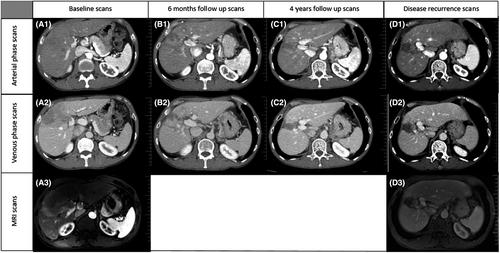Very late local recurrences of hepatocellular carcinoma with macrovascular invasion treated with stereotactic body radiotherapy: Report of two cases
Abstract
Background and Aims
Stereotactic body radiotherapy (SBRT) for hepatocellular carcinoma (HCC) is becoming an accepted local therapy in patients who are not candidates for surgical intervention, ablation or transarterial chemo-embolization. In patients with HCC with macrovascular invasion, SBRT is sometimes the treatment of choice, especially when systemic therapies are contraindicated, not available or if the HCC is refractory to systemic therapy.
Methods
We present two cases of HCC with tumour macrovascular invasion treated with SBRT. Both tumours appeared to have a complete response to SBRT over the subsequent 5 years.
Results
Very late, in-field local recurrences of HCC were diagnosed 73 and 78 months following SBRT. One patient underwent re-irradiation, was started on Levatinib and remains alive at 12 months following his recurrence. The other patient experienced rapid hepatic and extra-hepatic HCC progression shortly after the local recurrence occurred, and they expired 6 months later.
Conclusions
We demonstrate that patients treated with SBRT for HCC, with or without vascular invasion, may have prolonged tumour control and overall survival beyond 5 years. As more HCC patients are living longer compared to historical cohorts, it has become apparent that very late local recurrences of HCC may occur highlighting the need for long-term surveillance.


 求助内容:
求助内容: 应助结果提醒方式:
应助结果提醒方式:


